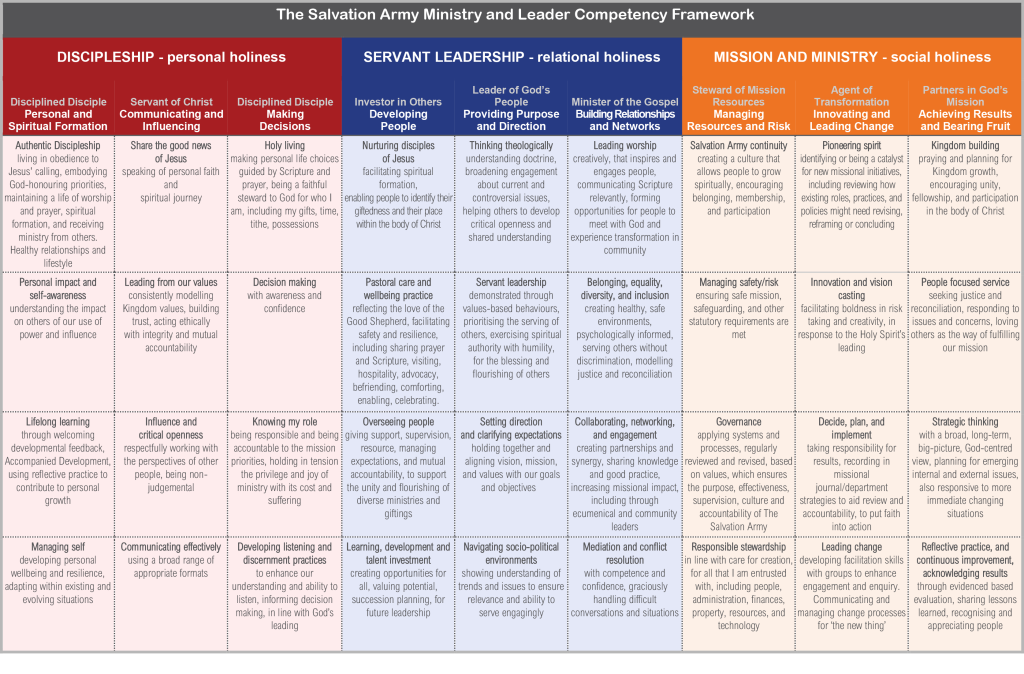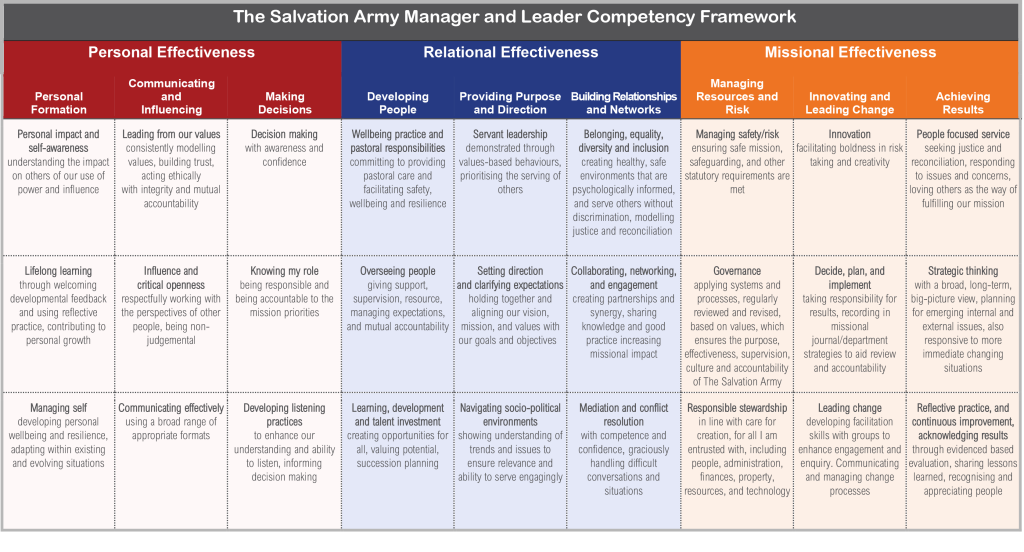...
Leader Competency Frameworks
Ministry and Leader Competency Framework
Introduction
Why this framework?
This framework is presented as part of a leader development strategy, building on the Vocational Development Pathway.
Manager and Leader Competency Framework
Introduction
Why this framework?
This framework is presented as part of a leader development strategy, linked to the Valuing People framework.
USING THE LEADER FRAMEWORK AND SUPPORTING RESOURCES
- OurHub pages:
- HR WBC,
- Officer Department,
- Leadership: Leader Development
- wbclearningdevelopment.org
- iLearn
- Salvationist.org
Accessible on your computer, laptop, smart phone, and copies can be downloaded from the website
The best place to start is to complete a self-assessment questionnaire. This gives you a chance to consider where your current strengths are, what is critical in your role at the moment, and where your development priorities lie. To round out your perspective you may want to gather feedback from others. This overview will hopefully clarify which areas of development you want to focus on first.
Alternatively, you may already have a sense of where you need to focus. If so, you can head straight to the framework and standards to help consider what ongoing development might look like or browse to see if something feels particularly relevant.
Ideas and opportunities can be found on wbclearningdevelopment.org which signpost learning resources and activities linked to competencies. These comprise:
- An introductory learning page on each of the nine themes in the framework incorporating a ‘test yourself’ on the topic, and to help embed your learning a ‘reflective practice template’.
- Learning resources catalogue with summaries and links for further exploration.
- For officers and territorial envoys, DEVELOP platform on iLearn to support the creation of individual learning plans and social learning connections (link)
Ideas for Leaders and Managers:
- During one-to-one meetings, integrate framework discussions naturally. For instance:
- If discussing delegation, explore relevant competencies like Developing Others:
- Competency 4.4: ‘Learning development and talent investment’
- Competency 8.2: ‘Decide, plan and implement’.
- For tricky relationship issues, consider elements like Building Relationships,
- Competency 6.2: ‘Collaborating, networking and engagement’.
- Competency 6.3: ‘Mediation and conflict resolution contributions’.
- If discussing delegation, explore relevant competencies like Developing Others:
- Alternatively, review competencies together. Encourage your team member to select one for discussion, allowing them to lead. Conclude with actionable steps and follow up in the next one-to-one.
Ideas for Direct Reports and Reviewees:
- Share successes or challenges using framework context. Note relevant elements and discuss during one-to-ones.
- Prompt your manager to assess your work against the framework. Incorporate their feedback in your ongoing development plans.
- Utilise the framework to pinpoint areas for skill enhancement. Discuss your progress and insights during one-to-ones.
- Identify skills needed for mission and ministry development or career progression using the framework. Focus on bridging skill gaps between current and desired roles and opportunities.
Things to think about:
In one to ones you will be reviewing objectives and setting new ones, it’s also the perfect opportunity to reflect and think more broadly, to reflect on progress, and consider together what further development is appropriate and how it will take place, as well as focusing on the competencies we should be demonstrating.
When preparing for the one to one, reviewers and reviewees can reflect on the framework elements and identify some strengths and areas for development against these.
The EEC feedback model is a simple way to structure constructive feedback.
Example: Give a specific example of the behaviour you’ve observed
Effect: Describe what effect it had – positive or negative
Change/congratulate: Discuss and agree what they should do in the future or congratulate them if a positive.
The EEC feedback model is a useful tool for giving feedback that is clear, honest, and open. It helps to ensure that the feedback is constructive and focused on behaviour, rather than personality or character.
Use the leadership framework within VIPs or Care and Equip to explore and record thinking about leadership behaviours and competencies.
Use a personal learning development plan to make sure that aspirations turn into firm plans. Plan together how you will use the exercises in the framework resources, what support is available and how you will check in and follow up.
You can use the Leadership Framework and resources with the whole team or several team members. For more ideas on team development, take a look at the website or talk to your Learning and Development Partner.
People do not need to have ‘leader’ or ‘manager’ in their title to benefit from the framework, anyone can display leadership behaviours. Someone who comes up with a good idea for how you could improve a process is seeking to do things better. Someone who spots an opportunity, or a risk, brings it to the team’s attention is thinking ahead and taking an open and long-term view of possibilities. Team members who encourage and value feedback and contributions from their colleagues are showing their capabilities in working with others.
Please see below for some suggestions for using the framework in team development:
- Invite the team to look at the competencies in advance of a team meeting and consider how relevant do they think it is to them? Could they see ways in which it could be used? Which areas seem like team strengths or areas for development? You can use a RAG (Red, Amber, Green) rating to determine a picture of team strengths and priority development areas. Discuss the implications together, and invite the team to identify next steps together. Be clear on how you plan to follow these up.
- At the end of a team meeting or during an away day, or when reviewing a project together, invite team members to consider if as a team you demonstrated any of the competencies in the framework, what was demonstrated and what the learnings are. Agree next steps together and how you plan to follow these up. Encourage team members to use the relevant resources to further their own development.
- Using Team Exercises (currently in development) to review and discuss effectiveness and development in you context. Using your analysis, or drawing on the team’s analysis of strengths and areas for development, select an appropriate exercise to use with the team. Share the activity and invite team members to discuss their thinking in pairs and then bring ideas to the whole team. Be clear who is recording learning and how it will be shared, used and followed up.
When recruiting to jobs that involve managing people, it can be hard to create selection criteria that are specific enough to be really useful in the recruitment process. Asking prospective applicants whether they have experience in managing others is so vague, and so open to interpretation, that it is unlikely to be helpful. You may miss out on good candidates because they don’t know exactly what you are looking for, so can’t tailor their applications effectively.
The framework gives you the opportunity, as a recruiter, to think in detail about the things you want a new people manager to be able to do. It is designed to give concrete terms for the capabilities required for effectively leading and managing others and in many cases you will be able to use their wording as criteria with little or no change.
Here are three examples of how you might work through the process, with help from the framework.
Alternatively, you could include the leadership framework in the application pack. You could also highlight some key elements. Ask candidates to refer to the framework in their application statement, or ask candidates to share an example where they have demonstrated one of the elements in their application.
New members of staff need to understand what is expected of them in their role, otherwise problems may arise with successful completion of the probationary period. For those starting new manager roles, you can use the Leadership Framework to set out the expectations for leadership and management behaviours. You can signpost them to the framework and you can ask them to self–assess or ask them to look at competencies related to specific management behaviours which you feel are a priority for the role, or which their application process indicated could be a personal development area.
Include reference to the framework in the induction plan and probation documentation.
When you review the probationary period, invite the new manager to share any learning, development or future goals in relation to the competencies in the framework.


